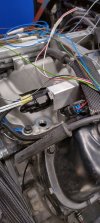Hi again,
trying to install the last sensors on the engine for the EFI.
One that I haven't been able to get any good information on yet is where I should place the knock sensor.
I found several threads that warned about placing two (one for each bank), but none that actually talked about the best location for a sensor on the original block.
Any thoughts?
Second question is placement of IAT (inlet air temp) sensor.
I will have a hard time fitting it in the collected inlet or throttle body.
So I was thinking about drilling it in the lower air filter plate that mounts onto the throttle body.
The sensor would not read the average air temp in the inlet, but atleast it reads the ingoing air.
Would that be accurate enough?
trying to install the last sensors on the engine for the EFI.
One that I haven't been able to get any good information on yet is where I should place the knock sensor.
I found several threads that warned about placing two (one for each bank), but none that actually talked about the best location for a sensor on the original block.
Any thoughts?
Second question is placement of IAT (inlet air temp) sensor.
I will have a hard time fitting it in the collected inlet or throttle body.
So I was thinking about drilling it in the lower air filter plate that mounts onto the throttle body.
The sensor would not read the average air temp in the inlet, but atleast it reads the ingoing air.
Would that be accurate enough?

